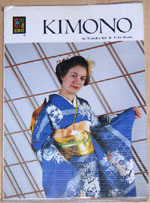“Kimono” by Ito and Inoue
This book was discovered on ebay by fellow kimono fan moonblossom, and can be found on:
o Amazon.com: Kimono (currently unavailable, sometimes used copies will appear)
o Amazon UK: Kimono (Special order. £7.95, or about US$15)
Originally published in 1979 by Hoikusha in their Color Books series (which includes such titles as Katsura, Sumi-e, Tea Ceremony and Kyoto Gardens), this book is a bit like a time capsule. Despite its age, it is without a doubt the best English book I’ve read on kitsuke and kimono types.
There were a few things that I hadn’t heard or read before: on page 4, they say a kurotomesode can be worn with a pink kanoko shibori obiage and nagajuban of vermillion, red or pink by young women. I had always heard that kurotomesode were to be worn with white obiage and nagajuban, and wondered what they meant by “young women” since I’d always thought they were worn by mothers of the bride and groom. This mystery was solved on page 98, where they mention that kurotomesode are “worn at weddings or any formal congratulatory occasion.” Concerning kitsuke, for wearing a nagajuban, the book says that “the datemaki” (datejime) “is wrapped around the body from the chest down to the waist.” I’d never seen this before: you start at the chest and wind down, rather than crossing over at the back to keep it at the same level. They do the same when putting on the kimono. After trying it out myself, it is indeed a great idea, as it makes for a thinner and yet more solid base.
The kitsuke directions are excellent. They show how to wear a furisode and houmongi (the model uses a chuburisode – furisode with mid-length sleeves), tie a fukuro obi in Mandarin duck bow (oshidori musubi, looks just like a fukura suzume), wear two types of yukata, and tie two hanhaba obi musubi (ichimoji kuzushi, which looks like a bunko musubi, and chô musubi). Then there are directions for an otaiko musubi tied with a fukuro nagoya obi, and two drum bow variations done with nagoya obi, which look quite original.
In addition to that, the book goes into all the different types of kimono and describes their different levels of formality, has sections on summer weaves and regional weaves, dyeing techniques etc., and is filled with wonderful photos. I found their explanation of houmongi and tsukesage to be especially informative, so would like to quote it:
There are all kinds of houmongi, from formal kimono that are embroidered, tie-dyed or yuzen-dyed to informal batik and sarasa prints. [Sarasa are printed patterns inspired by Indian and/or Indonesian motifs.] There are also various types of tsukesage from informal hand-painted kimono to those with embroidered patterns placed at random over a large area of plain fabric. The latter have a dyed or embroidered crest at the back and usually can be worn like houmongi.
[Regarding tsukesage komon] Even though it is a komon type, it is a ‘good’ kimono and can be worn for theater and informal social events, as well as for town.
